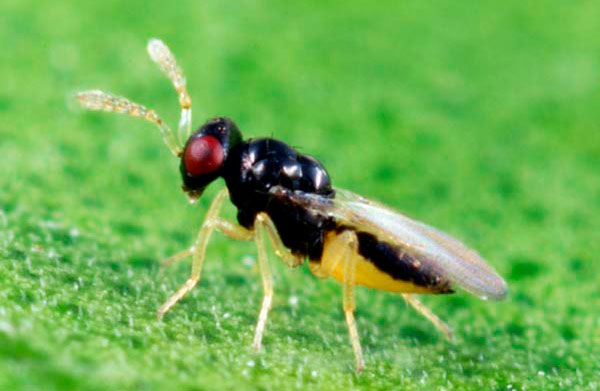
By John Cox, Bakersfield Californian
Tiny wasps are here to save the day!
In response to a local surge in detections of a pest threatening to wipe out California’s citrus industry, a coalition of researchers and government officials last (month) released thousands of pinhead-size wasps called Tamarixia radiata into neighborhoods around Kern County.
The wasps are native to Pakistan and natural predators of the Asian citrus psyllid, a larger but still teensy pest that can carry the untreatable disease Huanglongbing, which devastated Florida’s citrus industry and now lurks in Southern California.
HLB, as the disease is commonly known, hasn’t been found in the Central Valley so far. But researchers worry it will eventually cross into the region. The bigger question is whether they can develop, approve and distribute a cure before that happens.
Harmless to humans, the Tamarixia wasps feed only on Asian citrus psyllids, research has found. What’s more, they parasitize the psyllid’s nymphs, said Victoria Hornbaker, director of the Citrus Pest & Disease Prevention Program.
By that she means the wasps lay eggs under nymph, and when they hatch, the young wasps burrow into the nymph, eat it and emerge from its head.
“It’s pretty gruesome to watch but also kind of cool,” Hornbaker said.
Already this year 74 citrus psyllids have been found in Kern, with the rate increasing in September and October, according to the pest and disease prevention program, which is an initiative funded by growers and administered by the California Department of Food and Agriculture. It said the detections have been clustered recently in the Arvin, Bakersfield, Lamont and Maricopa areas.
More broadly, the pests have been found in more than 2,000 trees south of Fresno and in the counties of Los Angeles, Orange, Riverside, San Bernardino, San Diego, Santa Barbara and Ventura. HLB’s spread has mostly been limited to L.A. and Orange counties. (A map of where psyllids have been found, wasps have been released and HLB has been detected is available online at https://ucanr.edu/sites/ACP/Distribution_of_ACP_in_California/.)
Almost 10,000 of the wasps were released in the areas of Arvin, Bakersfield, Lamont and Maricopa. Additional mass releases of wasps are scheduled for the months ahead.
It’s not the first time the wasps have been released locally. In 2016, thousands of them were released around Bakersfield to combat the citrus psyllid. They’ve also been deployed across Southern California as detections of the psyllid and HLB itself have soared in recent years.
Kern, at the southernmost portion of the Central Valley, faces the valley’s biggest financial risk. Citrus was the county’s third highest-grossing crop in 2019, when it brought in just shy of $1 billion.
The situation has prompted people within the prevention program to call for extra vigilance on the part of residents whose backyard fruit trees may already be infected with the mottled brown pest, which measures about the size of an aphid and feeds with its body at a 45-degree angle. Young psyllids are yellowish-orange and put out a waxy white substance visible on leaves.
“Kern County residents are being asked to inspect their backyard trees for ACP and to be aware that the California Department of Food and Agriculture … will be surveying citrus trees in the area near the detection sites to look for additional psyllids,” the pest prevention program said in a news release. “Residents may also notice yellow sticky traps being placed in citrus trees.”
The organization has urged property owners to keep an eye out for the psyllid when watering, pruning, spraying or otherwise tending to their citrus trees. Anyone who spots one is asked to call the CDFA’s free pest hotline: 800-491-1899.
It says the psyllids are mostly likely to be found on new leaves. Symptoms include blotchy or yellowing leaves, it said, as well as yellow shoots and lopsided, small and bitter fruit. It listed premature or excessive fruit drop as another sign of infection.
Another important measure it listed is to avoid moving citrus plants, foliage or fruit between regions.


